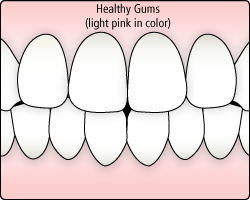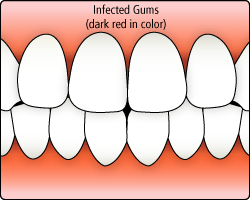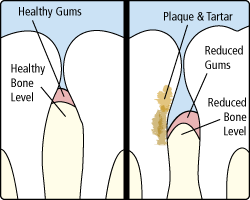Gum Disease
Gum disease (also called periodontal disease) is an infection of the tissues that support your child's teeth.
It is a major cause of tooth loss in adults. Because gum disease is usually painless, you may not know your child has it. At each regular checkup Dr. Sanchez and her hygienist will evaluate your child's gingival health.


Gum disease is caused by plaque, a sticky film of bacteria that constantly forms on the teeth. These bacteria create toxins that can damage the gums.
Periodontal diseases attack just below the gum line in the sulcus, where they cause the attachment of the tooth and supporting tissues to break down. As the tissues are damaged, the sulcus develops into a pocket; generally, the more severe the disease, the greater the depth of the pocket.
Periodontal diseases are classified according to the severity of the disease. The two major stages are gingivitis and periodontitis.
Gingivitis
In the early stage of gum disease, called gingivitis, the gums become red, swollen and bleed easily. At this stage, the disease is still reversible and can usually be eliminated by daily brushing and flossing.

Periodontitis
In the more advanced stages of gum disease, called periodontitis, the gums and bone that support the teeth become seriously damaged. Whereas healthy gums and bone anchor teeth firmly in place, infected gums can cause teeth to become loose, fall out, or have to be removed by a dentist.
If you notice any of the following signs of gum disease, please make a dental appointment for your child:
- Gums that bleed easily
- Red, swollen, tender gums
- Gums that have pulled away from the teeth
- Persistent bad breath or bad taste
- Pus between your child's teeth and gums
- Permanent teeth that are loose or separating
- Any change in the way your child's teeth fit together when they bite
- Any change in the fit of a removable space maintainer or retainer
It is possible to have periodontal disease and have no warning signs.
That is one reason why regular dental checkups and periodontal examinations are very important. Treatment methods depend on the type of disease and how far the condition has progressed.
Good oral hygiene at home is essential to keep periodontal disease from becoming more serious or recurring. Help your child brush regularly, clean between their teeth, eat a balanced diet, and schedule regular dental visits for a lifetime of healthy smiles. If your child is in braces, make sure they have some different tools to help them floss, such as floss threaders. If your child has a fixed (glued-in) retainer then you may want to purchase a water pick to help them remove food debris from the retainer. A proxy brush may help them clean around their brackets better at the gumline.
